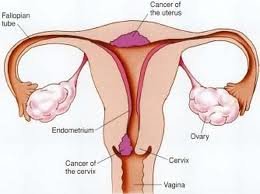Cervical cancer stages are classified into five. Like other cancers, the stages of cervical cancer are numbered from 0 to 4. Each stage has unique symptoms, causes and treatments. There are also common signs for all of the stages.
Cervical cancer is a malignant cancer that occurs in women. This is developed in the cells of the cervix which is located in the pelvic region that is the lower part of the uterus that connects to the vagina. It is primarily caused by sexually transmitted diseases such as Chlamydia, human papillomavirus (HPV) and human immunodeficiency virus (HIV). Sometimes, this can also caused by bad habits and unhealthy lifestyles like smoking cigarettes, drinking alcohol and eating junk foods.
Staging cervical cancer is grouped into two types. The first type is called squamous cell carcinomas which is the most common, and the second one is adenocarcinomas. Squamous cell carcinomas develop in the thin cells that line the bottom part of the cervix. Adenocarinomas start in the glandular cells which line the upper side of the cervix.
The earlier stage is stage 0 which only occurs on the surface of the cervix. This means that it has not yet spread into deeper tissues in the cervix.
Cervical cancer stage 1 is the second stage. Both cervical cancer stages 0 and 1 remain on the surface of the cervix. However, the cells have already started to spread and infect into deeper tissues.
Stage 2 cervical cancer is identified if the cells have spread to the surrounding tissues of the cervix. The most commonly affected part is the upper area of the vagina.
The stage 3 of this cancer begins to spread outside of the cervix. The cells could be spread down and inside the vagina as well as into the muscles which line the lower part of the pelvic wall. If not, the cells may have spread up toward the bladder that usually blocks the flow of urine which drain into the bladder.
Stage 4 cervical cancer is the most serious and critical stage. The reason is because the cells have already spread to all parts of the body including the uterus and vagina. The cancer can possibly spread from the uterus to the bladder and from the abdomen to the lungs until the entire body is affected. This happens if the other cervical cancer stages are not treated immediately.
Depending on the cervical cancer stages symptoms will always occur. Earlier stages typically have fewer symptoms and sometimes they are not noticeable. Real symptoms of this cancer are usually more visible and obvious during the later stages. The common symptoms and signs are vaginal discharge, abnormal bleeding, painful feeling in the vagina during intercourse and ache in the pelvic region.
For the treatment, there are different ways to cure cervical cancer. Of course, that depends on the cervical cancer stages. Stage 0 may be treated through cryotherapy, laser therapy, conization or electrocautery. The first stage of the cancer can be cured through vaginal radiation therapy, conization and laser therapy. Stages 2 and 3 are commonly treated by way of radiation therapy. The treatment for the critical stage 4 is through pelvic exenteration.
You can assure if you are suffering from this cancer through Pap smear. Any pre-cancerous cells can be detected and treated if they are detected as early as possible. So, to avoid being diagnosed with this cancer, especially the later cervical cancer stages, you must consult a doctor regularly and undergo Pap smear annually. It is important to avoid this kind of cancer as this can threaten your health. Remember that it is better to be safe than to be sorry and regret afterwards.
